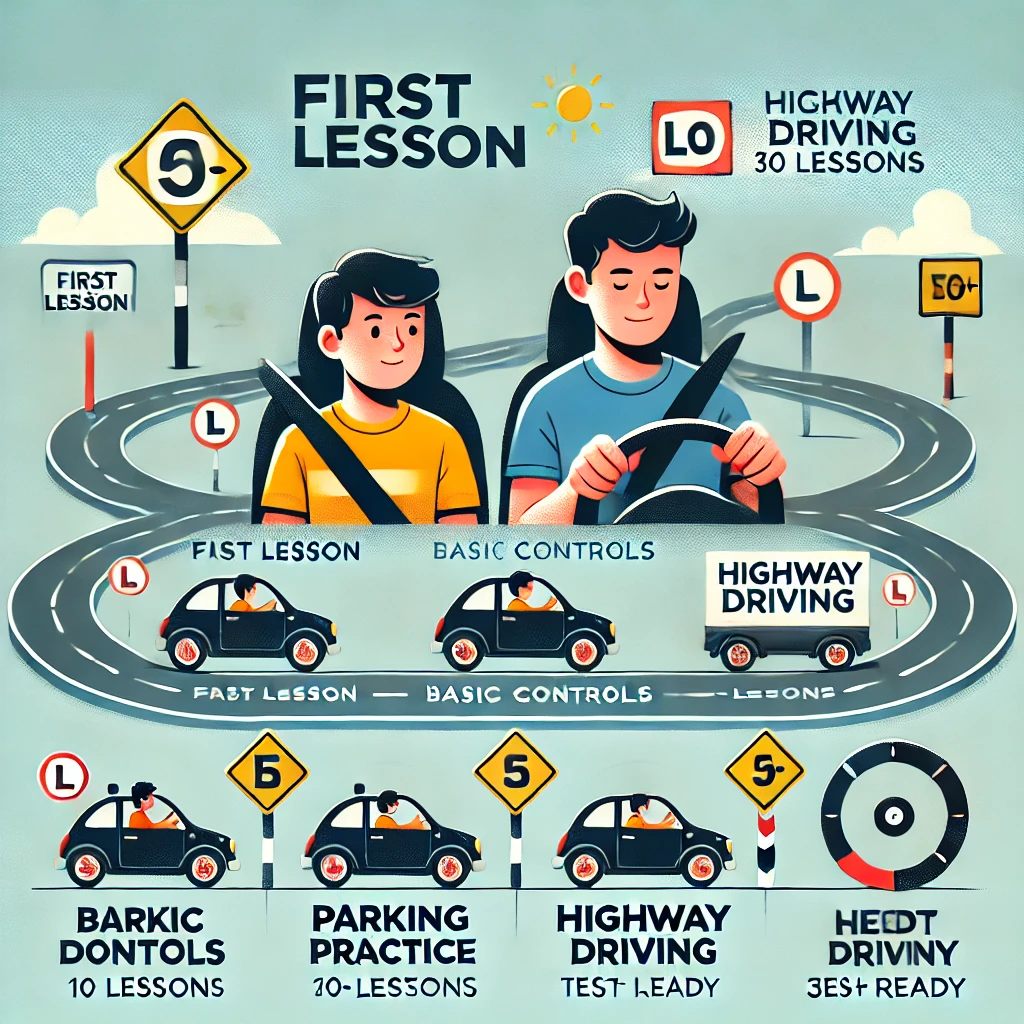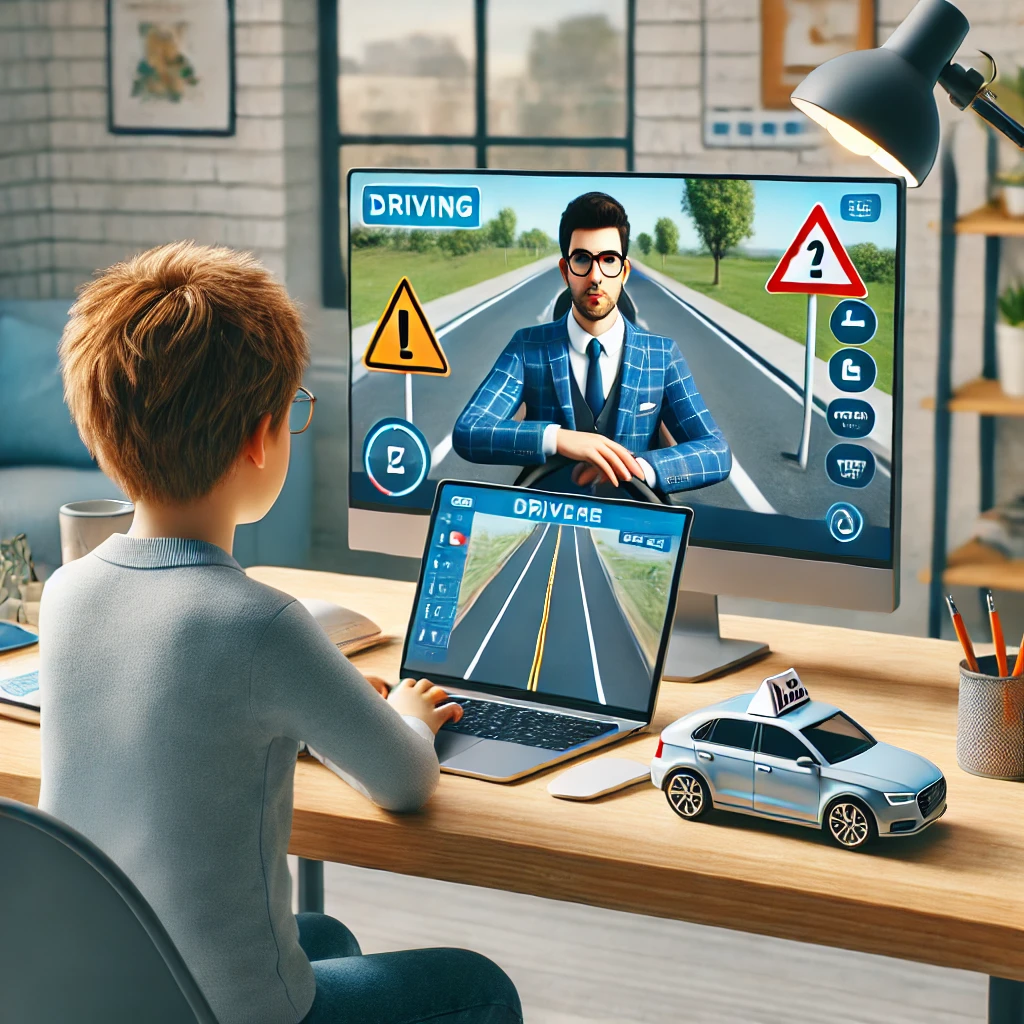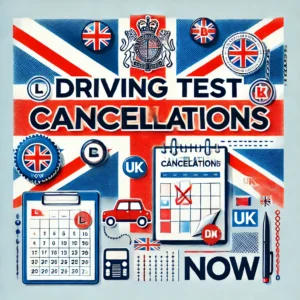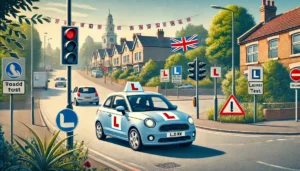
One of the most common questions I get asked as a driving Instructor is, "How many driving lessons will I need?"
The answer varies depending on individual experience, confidence, and ability to grasp driving techniques. However, the DVSA (Driver and Vehicle Standards Agency) recommends that most learners require around 45 hours of professional lessons and an additional 22 hours of private practice to pass their driving test.
How would you like too reduce that number significantly while still becoming a safe, confident driver, however my students use my courses to reduce the hours they have in the car in time saving them money on lessons, all for the price of one driving lesson.?
That’s exactly what our online driving course is designed to do!
By supplementing traditional lessons with our expertly crafted course, you’ll accelerate your learning, cut down on paid lesson hours, and be test ready much faster by buy building a foundation of knowledge and also knowing the answers of your driving Instructors questions before they even ask you them.
Who will the online driving courses help?

Unlike traditional lessons, which are limited by instructor availability, our online driving course allows you to study and practice key driving concepts at your own convenience giving you an advantage of knowing the syllabus and how your instructor will teach you even before you get in the car with them.
Whether it’s mastering roundabouts, parallel parking, or lane discipline, our interactive lessons will help you understand these topics before you even hit the road.
This means that when you do take professional lessons, you’ll already have the knowledge, reducing the time (and cost) needed to get test ready.
TIP: REMEBER, ANYTHING IN LIFE IS KNOWLDEGE, THE MORE YOU HAVE THE LESS ANXIOUS YOU WILL BE, GAIN AS MUCH KNOWLEDGE WHETHER IT BE ONLINE COURSE OR JUST READING TO GIVE YOURESLF THE BEST CHACNE TO REDUCE THE HOURS YOU DO WITH A DRIVING INSTRUCTOR
With our online driving course, many learners find they can reduce their professional lesson hours by up to 30%. That means instead of the typical 45 hours, you might only need around 30-35 hours of paid lessons.
Because our course gives you a head start by covering essential driving theory, hazard perception, and real life driving scenarios in a structured way exactly how I teach my students in car.
When you begin lessons with an instructor, you’ll already understand the rules of the road, common mistakes to avoid, and how to handle different traffic situations.
This allows your instructor to focus more on fine tuning your driving skills rather than teaching the basics from scratch.
Driving lessons can be expensive, with the average cost per lesson ranging between £30-£50. If you need 45 lessons, that could add up to £1,350-£2,250! By using our online driving course to reduce the number of lessons required, you can save hundreds of pounds while still becoming a competent driver.
Our online course includes interactive quizzes, real life driving scenarios, and practical tips to help reinforce learning. You’ll also get access to mock driving tests with your driving instructor, so you’ll know exactly what to expect on your test day, boosting your confidence and increasing your chances of passing on the first attempt.
If you’re asking, "How many driving lessons will I need?" the answer is fewer than you think when you use our online driving course. Don’t waste time and money on extra lessons. Enrol today and fast track your journey to becoming a skilled and confident driver!


At JNDS Online.co.uk , whether you're a beginner or looking to refresh your skills or an international licence permit holder looking to learn the structure of driving lessons in the UK, our driving lessons online offer the perfect solution, these courses are also perfect for anyone learning with a family member.
With our expert guidance, and interactive learning experiences, you can make learning to drive at your own pace enjoyable, gain knowledge before for your first lesson and know what too expect, all from the comfort of your home!
Traditional driving schools are not cheap, going into the unknown and learning from scratch can become more expensive, however for the price of a driving lesson you are gaining knowledge in every subject, build a foundation of knowledge and become familiar with everything before jumping in the car with an instructor saving you time and money learning.
Online driving lessons, on the other hand, provide a convenient and cost effective way to learn essential driving skills before . Here’s why they are the best choice:
With online driving lessons, you can learn at your own convenience, on your, tablet, or computer or even phone, whenever you’re ready.
From interactive videos and quizzes to real life driving simulations, online lessons provide in depth knowledge about road signs, defensive driving techniques, parking, and general road navigation.
Top rated online driving courses are developed by an official fully qualified driving Instructor with the use of full syllabus we would teach in car with our real students instructors and experienced drivers, ensuring you receive high quality, structured approach tailored to various skill levels.
Save money on traditional in person classes by opting for budget friendly online lessons. Many platforms also offer payment plans and discounts to make learning to drive even more accessible, with our courses they are a great price, whether your a new driver. nervous or have even had lessons prior.
Our online driving courses include practice tests that mirror real life written exams, helping you pass your driving test with confidence.
When you enrol in an online driving course, you gain access to structured modules designed to make learning easy and engaging in exactly the same way and order we would do things in car.
Online driving lessons are perfect for:
With driving lessons online, you can gain the confidence and skills needed to become a safe, responsible driver. Don’t wait start learning today and get one step closer to passing your test and hitting the open road!
Sign up now and take the first step toward driving independence!

As a driving instructor, one of the biggest frustrations my students face is the long waiting times for driving tests. Whether due to high demand, backlogs, or personal circumstances, waiting months for a test date can be disheartening.
That’s where the Driving Test Cancellations Now app has completely transformed the experience for my students and me. It’s no exaggeration to say this app has become an indispensable tool in my work. Let me explain why.
CLICK HERE TO JUMP THE WAITING TIMES FOR YOUR LOCAL DRIVING TEST CENTRE LIKE O DO WITH MY STUDENTS
Before diving into the app’s features, let’s briefly touch on the root cause of the problem. Driving test cancellations occur when candidates reschedule their tests, fail to show up, or are unable to attend, and there is many other reasons why driving test become available.
While these cancellations create opportunities for others, manually checking for these openings is time-consuming and often impractical.
This is where Driving Test Cancellations Now shines. It uses smart technology to scan the DVSA’s booking system for earlier test slots, notifying users as soon as a cancellation becomes available.
For someone like me, a driving instructor with multiple students preparing for their tests, this app has been a game changer.
The Driving Test Cancellations Now app isn’t just another convenience tool it’s a necessity for anyone serious about getting a test date sooner. Many of my students have hectic schedules with school, university, or work commitments, making the ability to secure a suitable test date essential.
I’ve tested a few similar services in the past, but none compare to Driving Test Cancellations Now. Here are some reasons it stands out:
One of my students, Shannon, had her test scheduled three months away, but thanks to Driving Test Cancellations Now, she managed to secure a slot just two weeks later. This not only saved her time but also kept her motivated and confident. Success stories like Shannon's are why I continue to recommend the app.
The Driving Test Cancellations Now app is, without a doubt, the number one driving test cancellations app available today. Whether you’re an individual eager to get your license sooner or a driving instructor managing multiple students, this app will save you time, reduce stress, and make the entire process smoother.
Don’t let long waiting lists delay your driving goals download Driving Test Cancellations Now and take control of your test dates today!

For anyone preparing for their practical driving test, knowing the driving test routes UK examiners commonly use can make a significant difference in your readiness and confidence. As a driving instructor.
I’ve seen firsthand how mastering these routes can help students pass their tests. In this blog post, I’ll share tips on how to access these routes and introduce you to Route Buddy, the number one app for driving test routes in the UK.
Driving test routes UK wide are designed to challenge learners with a variety of road types and scenarios.
From busy roundabouts to quiet residential streets, these routes test your ability to adapt and demonstrate safe driving practices. By familiarizing yourself with these routes, you’ll know what to expect and can focus on improving your skills rather than worrying about the unknown.
CLICK HERE FOR THE NO 1 DRIVING TEST ROUTES APP IN THE UK
There are several ways to get your hands on the driving test routes UK:
As a driving instructor, I’ve been using Route Buddy with my students and they love it, and it’s been a game changer. The app includes accurate routes for test centres across the UK, so I can plan lessons to cover these areas in depth.
This not only boosts my students’ confidence but also ensures they’re familiar with potential challenges they might face on test day.
One of the best features of Route Buddy is its GPS guided maps, which allow me to simulate the test environment precisely. For example, if I know a tricky roundabout is part of the route, I’ll take my students there during practice sessions to ensure they’re prepared.
I’ve noticed a significant improvement in my students’ pass rates since incorporating this tool into my lessons.
CLICK HERE FOR THE NO 1 DRIVING TEST ROUTES APP IN THE UK
Getting to know the driving test routes UK can significantly enhance your chances of passing the practical driving test.
While traditional methods like asking your instructor or searching online can be helpful, the best option by far is Route Buddy. As the number one app for driving test routes UK, it offers the accuracy, convenience, and tools you need to succeed.
As an instructor, I’ve seen how using Route Buddy helps my students not only familiarize themselves with the routes but also develop the skills and confidence they need to pass.
Whether you’re an instructor like me or a learner preparing for your test, Route Buddy is the ultimate companion on your journey to driving success.


Being a driving Instructor and a father I take passion in reviewing products even in the midst of buying, everything has its pros and cons but for me the best convertible car seat for an infant does have to be this one.
When it comes to selecting a convertible car seat for infants, parents are faced with an overwhelming number of choices. Safety, comfort, and longevity are key considerations, but let’s not forget about style and affordability.
Enter the COSATTO Zoomi Car Seat, a standout option that checks all the boxes for modern parents looking for the best for their little ones.
A convertible car seat for infants is a versatile piece of baby gear designed to adapt as your child grows. These seats typically begin as rear facing for infants, then convert to a forward facing car seat, and in some cases, even to a booster seat. The idea is to invest in one seat that evolves with your child, eliminating the need for multiple purchases.
The COSATTO Zoomi Car Seat is not just a car seat; it’s a long-term companion for your growing child. Designed for children from 9 months to 12 years old, it grows with your baby, offering exceptional value for money.
Let’s delve into the features that make this car seat a must have.
If you’re in the market for a convertible car seat for infants, the COSATTO Zoomi is hard to beat. With its impressive safety features, comfort-driven design, and long-lasting durability, it’s a purchase that will grow with your family and save you money in the long run. Plus, its vibrant and stylish designs make it a joy to use daily.
Invest in the COSATTO Zoomi Car Seat and enjoy peace of mind knowing your child is safe, comfortable, and happy on every journey. It’s not just a car seat—it’s a smart investment in your child’s future.
Ready to upgrade your travel experience?
Choose the COSATTO Zoomi Car Seat today and discover why it’s the best convertible car seat for infants on the market.
